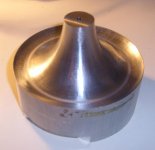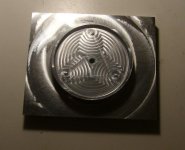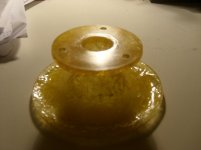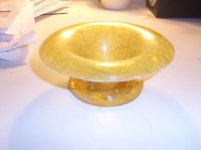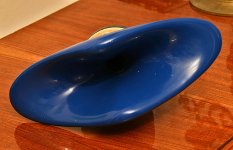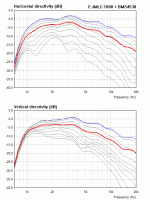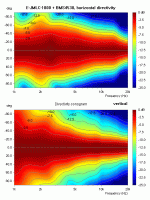I saw the earlier mention of ribbon horns. I had been looking into the idea for my ribbon midrange to see if it was possible (I have small ribbon tweeter, also. I was actually looking for lower Hz response. It has a radiating area of 3" by 7". Are you guys talking about square horns when talking about ribbons? And to compress the sound, could I just make an adapter with a small throat that I attach to horn? Or am I better off just making horn with throat of 3" by 7".
My midrange starts to drop off and is recommended to be crossed over at around 700 to 650 Hz. I was hoping to go as low as possible...
And one other question. It is open in the back, do I use the recommended 15L sealed enclosure?
Sorry for so many questions. I am new to the idea of designing horns/waveguides.
Todd
My midrange starts to drop off and is recommended to be crossed over at around 700 to 650 Hz. I was hoping to go as low as possible...
And one other question. It is open in the back, do I use the recommended 15L sealed enclosure?
Sorry for so many questions. I am new to the idea of designing horns/waveguides.
Todd
Contraindicated, Maybe!
When designing your horn, the following issues need to be addressed:
1) When you lower the c/o frequency below that recommended by the driver manufacturer, you risk overshooting driver displacement limits, particularly at frequencies where horn loading is diminished and/or driver resonance is approached. You may also expect increased distortion from the transformer used. In any event, driver warrantee, if any, will be voided by this type of application.
2) The shape of the horn throat should match that of the driver diaphragm; in this case, rectangular.
3) If the throat dimensions are to be made smaller than that of the driver diaphragm, then a phase plug will need to be designed to cancel standing wave modes in the front cavity that is created by doing so.
4) When signal wavelengths become comparable to transverse throat dimensions of 7” and 3” you may expect response irregularities at the corresponding frequencies as well.
You might want to consider replacing your midrange driver with one that bridges the woofer/tweeter frequency gap instead.
Regards,
WHG
I saw the earlier mention of ribbon horns. I had been looking into the idea for my ribbon midrange to see if it was possible (I have small ribbon tweeter, also. I was actually looking for lower Hz response. It has a radiating area of 3" by 7". Are you guys talking about square horns when talking about ribbons? And to compress the sound, could I just make an adapter with a small throat that I attach to horn? Or am I better off just making horn with throat of 3" by 7".
My midrange starts to drop off and is recommended to be crossed over at around 700 to 650 Hz. I was hoping to go as low as possible...
And one other question. It is open in the back, do I use the recommended 15L sealed enclosure?
Sorry for so many questions. I am new to the idea of designing horns/waveguides.
Todd
When designing your horn, the following issues need to be addressed:
1) When you lower the c/o frequency below that recommended by the driver manufacturer, you risk overshooting driver displacement limits, particularly at frequencies where horn loading is diminished and/or driver resonance is approached. You may also expect increased distortion from the transformer used. In any event, driver warrantee, if any, will be voided by this type of application.
2) The shape of the horn throat should match that of the driver diaphragm; in this case, rectangular.
3) If the throat dimensions are to be made smaller than that of the driver diaphragm, then a phase plug will need to be designed to cancel standing wave modes in the front cavity that is created by doing so.
4) When signal wavelengths become comparable to transverse throat dimensions of 7” and 3” you may expect response irregularities at the corresponding frequencies as well.
You might want to consider replacing your midrange driver with one that bridges the woofer/tweeter frequency gap instead.
Regards,
WHG
I don't have a gap necessarily, just seeing what kind of fun stuff I can play with 😀 If I decide to look into horn design, I should start with an appropriate driver!
Thanks for the info...
Thanks for the info...
Thanks!
Next up is a 750 (or so) Hz Lecleach mold, must find a large enough chunk of alu first.
Next up is a 750 (or so) Hz Lecleach mold, must find a large enough chunk of alu first.
The dream is to find a piece of alu and a machine big enough to make a 200Hz mold for 2" drivers, but that´s propably not going to happen...
I guess everything can be done with enough effort and money.
The 1600Hz mold didn´t cost me a cent to make, it´s machined out of a scrap piece and my brother did it as a favour (I´ve helped him repairing some electric stuff in his workshop). The 750Hz mold will cost something like 100 dollars if I can buy the metal through the company I work for and a guy there has offered to help me with the machining (again in return for some favours, of course).
A 200Hz piece would be a MUCH bigger project, too big to think of at this stage. Maybe is I could gather enough scrap aluminium and make a sand casting which the could be smoothed in a cnc mill or lathe...🙂
The 1600Hz mold didn´t cost me a cent to make, it´s machined out of a scrap piece and my brother did it as a favour (I´ve helped him repairing some electric stuff in his workshop). The 750Hz mold will cost something like 100 dollars if I can buy the metal through the company I work for and a guy there has offered to help me with the machining (again in return for some favours, of course).
A 200Hz piece would be a MUCH bigger project, too big to think of at this stage. Maybe is I could gather enough scrap aluminium and make a sand casting which the could be smoothed in a cnc mill or lathe...🙂
Go for the original Excel-spreadsheet instead this time. Much better to use with some features not found in Hornresp(haven´t found them anyway).
I think it is a very intelligent use of time materials and the trading of talents. I hope all works out well for you.
True DIY in the best sense.
True DIY in the best sense.
This looks very nice. I guess it's for compression drivers?E-JMLC-1000 - most beautiful small horn ever made? For sure can rival waveguides.
- Home
- Loudspeakers
- Multi-Way
- Jean Michel on LeCleac'h horns
